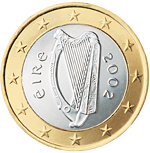
Irish euro coins all share the same design by Jarlath Hayes, that of the harp, a traditional symbol for Ireland since the Middle Ages, based on that of the Brian Boru harp, housed in Trinity College Dublin. The same harp is used as on the official seals of the Taoiseach, and government ministers and the Seal of the President of Ireland. The coins' design also features the 12 stars of the EU, the year of issue and the Irish name for Ireland, "Éire", in a traditional Gaelic script.

The guinea was a coin, minted in Great Britain between 1663 and 1814, that contained approximately one-quarter of an ounce of gold. The name came from the Guinea region in West Africa, from where much of the gold used to make the coins was sourced. It was the first English machine-struck gold coin, originally worth one pound, equal to twenty shillings, but rises in the price of gold relative to silver caused the value of the guinea to increase, at times to as high as thirty shillings. From 1717 to 1816, its value was officially fixed at twenty-one shillings.

The Florentine florin was a coin struck from 1252 to 1533 with no significant change in its design or metal content standard during that time. It had 54 grains of nominally pure or 'fine' gold with a purchasing power difficult to estimate but ranging according to social grouping and perspective from approximately 140 to 1000 modern US dollars. The name of the coin comes from the Giglio bottonato, the floral emblem of the city, which is represented at the head of the coin.
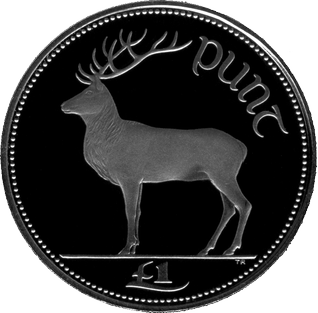
The pound was the currency of the Republic of Ireland until 2002. Its ISO 4217 code was IEP, and the symbol was £. The Irish pound was replaced by the euro on 1 January 1999. Euro currency did not begin circulation until the beginning of 2002.
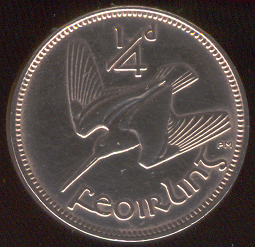
The farthing was the lowest value coin of the pre-decimal Irish pound, worth a quarter of a penny, 1⁄48 of a shilling or 1⁄960 of a pound. The coin had lost much of its value through inflation long before decimalisation in 1971, and during the 1960s no farthings were produced for general circulation; those minted in 1966 were produced for collectors' sets.
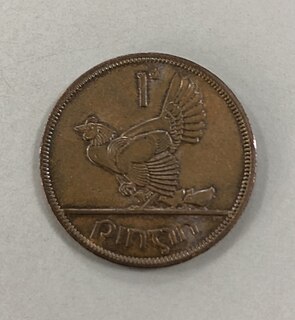
The penny (1d) coin was the third smallest denomination of the pre-decimal Irish pound, worth 1⁄240 of a pound or 1⁄12 of a shilling. To express an amount, penny was abbreviated to "d", e.g. 1d, from the Roman denarius. It was introduced in 1928 to replace its British counterpart, used when all of Ireland was a constituent country of the United Kingdom. The last year of minting was 1968 and it ceased to be legal tender on 31 December 1971.

The threepence or 3d coin was a subdivision of the pre-decimal Irish pound, worth 1⁄80 of a pound or 1⁄4 of a shilling. Leath reul literally means "half reul", the reul being a sixpence coin worth about the same as the Spanish real. As with all other Irish coins, it resembled its British counterpart, as the Irish pound was pegged to the British pound until 1979.
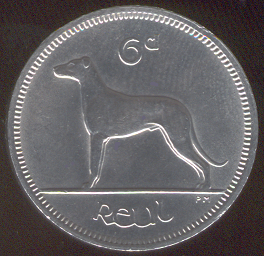
The sixpence coin was a subdivision of the pre-decimal Irish pound, worth 1⁄40 of a pound or 1⁄2 of a shilling. The Irish name réal is derived from the Spanish real; for most of the 19th century, a pound sterling was equal to five U.S. dollars, and a dollar was equal to eight reales, so that a real was equal to 1⁄40 of a pound. The variant spelling reul was used in the Coinage Act 1926, and appeared on the coins themselves even after a 1947 spelling reform established réal as the standard.
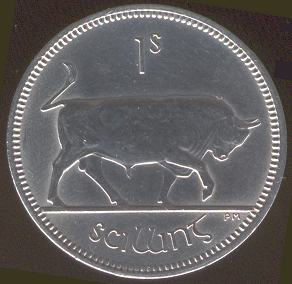
The shilling (1s) coin was a subdivision of the pre-decimal Irish pound, worth 1⁄20 of a pound. Worth 12d or half of a Florin.
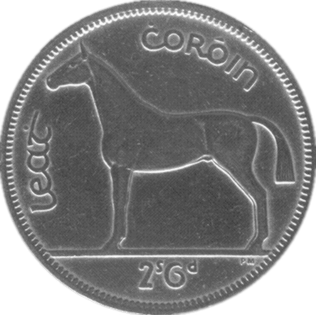
The half crown coin was a subdivision of the pre-decimal Irish pound, worth 1⁄8 of a pound. The half crown was commonly called "two and six" due to its value of two shillings and sixpence.
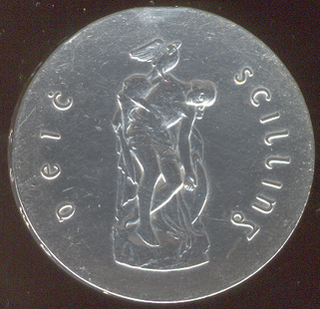
The ten shilling (10s) coin was a one-off commemorative coin issued in Ireland in 1966 to mark the 50th anniversary of the Easter Rising. Ten shillings was a subdivision of the pre-decimal Irish pound, worth 1⁄2 of an Irish pound, making this the highest value coin in the pre-decimal system.

The decimal halfpenny coin was the smallest denomination of the Irish pound. It was first issued when the Irish currency was decimalised on Decimal Day, 15 February 1971. It was one of three new designs introduced all in bronze and featuring ornamental birds on the reverse. The coin value was weakened by inflation and very few were produced beyond the initial run for 1971. It was removed from circulation and demonetised on 1 January 1987.

The decimal one penny (1p) coin was the second smallest denomination of the Irish pound. It was first issued when the Irish currency was decimalised on Decimal Day, 15 February 1971. It was the second of three new designs introduced all in bronze, the others being a half-penny and a two pence coin. All featured ornamental birds designed by Irish artist Gabriel Hayes on the reverse.
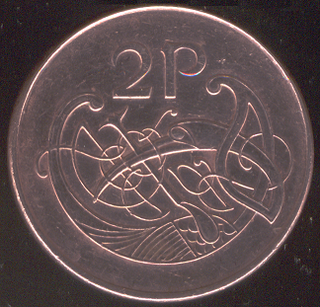
The two pence (2p) coin was the third smallest denomination of the Irish pound. It was first issued when the Irish currency was decimalised on Decimal Day, 15 February 1971. The coin was minted until 2000. It was the third of three new designs introduced all in bronze, the others being the halfpenny and penny. All featured ornamental birds on the reverse.

The five pence (5p) coin was a subdivision of the Irish pound. It was introduced in Ireland on Decimal Day, 15 February 1971 and reused the design on the shilling coin produced for the Irish Free State in 1928. Some shilling coins remained in circulation until the early 1990s, with the same nominal value as the five pence coin.

The ten pence (10p) coin was a subdivision of the Irish pound. It was used in the Republic of Ireland from 1969 to 2002, with its last minting issue in 2000. It replaced the florin coin, of which it shared its design. Two different designs of the coin exist, both featuring a salmon on the reverse. The second was introduced in 1993 and is smaller, due to the reduction of the coin's value by inflation.
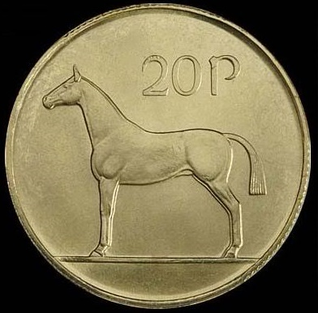
The twenty pence (20p) coin was a subdivision of the Irish pound. It was introduced on 30 October 1986. It was the first Irish decimal coin of a different size to the corresponding British coin, as the Irish pound had not been pegged to sterling since 1979. Its last issue was in 2000, two years before Ireland withdrew its pound for the euro.

The fifty pence (50p) coin was a subdivision of the Irish pound. It was introduced in Ireland on 17 February 1970. It replaced the ten shilling coin when decimalised, and due to this conversion was introduced a year before Decimal Day in 1971.

The one pound (£1) coin was the coin of the Irish pound. It was used in Ireland from 20 June 1990 until the formal adoption of euro currency in 2002. The last issue was minted in 2000.

Various commemorative coins denominated in Irish currency were issued until 2002, when the Irish pound (IEP/IR£) came to an end and was superseded by the euro. Since then there have been Irish commemorative coins denominated in euro.


















